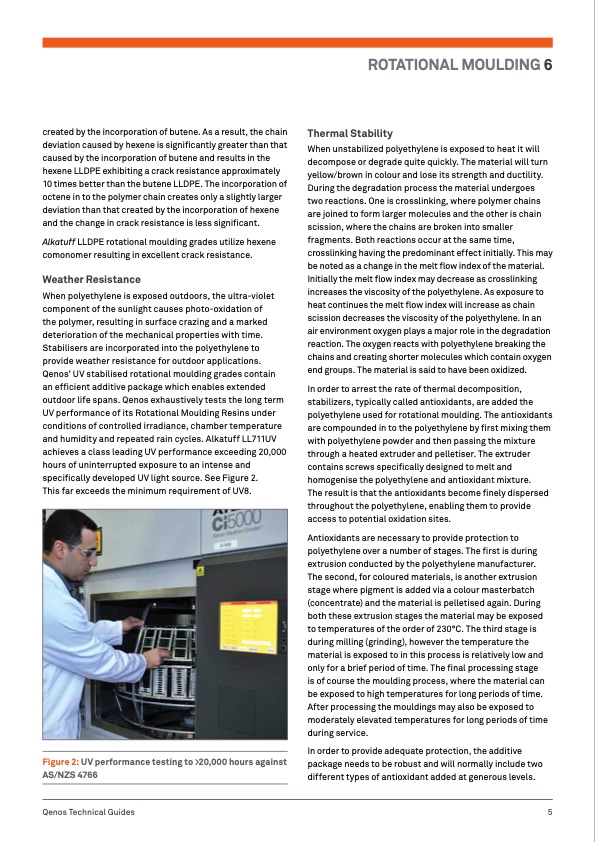
PDF Publication Title:
Text from PDF Page: 007
created by the incorporation of butene. As a result, the chain deviation caused by hexene is significantly greater than that caused by the incorporation of butene and results in the hexene LLDPE exhibiting a crack resistance approximately 10 times better than the butene LLDPE. The incorporation of octene in to the polymer chain creates only a slightly larger deviation than that created by the incorporation of hexene and the change in crack resistance is less significant. Alkatuff LLDPE rotational moulding grades utilize hexene comonomer resulting in excellent crack resistance. Weather Resistance When polyethylene is exposed outdoors, the ultra-violet component of the sunlight causes photo-oxidation of the polymer, resulting in surface crazing and a marked deterioration of the mechanical properties with time. Stabilisers are incorporated into the polyethylene to provide weather resistance for outdoor applications. Qenos’ UV stabilised rotational moulding grades contain an efficient additive package which enables extended outdoor life spans. Qenos exhaustively tests the long term UV performance of its Rotational Moulding Resins under conditions of controlled irradiance, chamber temperature and humidity and repeated rain cycles. Alkatuff LL711UV achieves a class leading UV performance exceeding 20,000 hours of uninterrupted exposure to an intense and specifically developed UV light source. See Figure 2. This far exceeds the minimum requirement of UV8. Figure 2: UV performance testing to >20,000 hours against AS/NZS 4766 ROTATIONAL MOULDING 6 Thermal Stability When unstabilized polyethylene is exposed to heat it will decompose or degrade quite quickly. The material will turn yellow/brown in colour and lose its strength and ductility. During the degradation process the material undergoes two reactions. One is crosslinking, where polymer chains are joined to form larger molecules and the other is chain scission, where the chains are broken into smaller fragments. Both reactions occur at the same time, crosslinking having the predominant effect initially. This may be noted as a change in the melt flow index of the material. Initially the melt flow index may decrease as crosslinking increases the viscosity of the polyethylene. As exposure to heat continues the melt flow index will increase as chain scission decreases the viscosity of the polyethylene. In an air environment oxygen plays a major role in the degradation reaction. The oxygen reacts with polyethylene breaking the chains and creating shorter molecules which contain oxygen end groups. The material is said to have been oxidized. In order to arrest the rate of thermal decomposition, stabilizers, typically called antioxidants, are added the polyethylene used for rotational moulding. The antioxidants are compounded in to the polyethylene by first mixing them with polyethylene powder and then passing the mixture through a heated extruder and pelletiser. The extruder contains screws specifically designed to melt and homogenise the polyethylene and antioxidant mixture. The result is that the antioxidants become finely dispersed throughout the polyethylene, enabling them to provide access to potential oxidation sites. Antioxidants are necessary to provide protection to polyethylene over a number of stages. The first is during extrusion conducted by the polyethylene manufacturer. The second, for coloured materials, is another extrusion stage where pigment is added via a colour masterbatch (concentrate) and the material is pelletised again. During both these extrusion stages the material may be exposed to temperatures of the order of 230°C. The third stage is during milling (grinding), however the temperature the material is exposed to in this process is relatively low and only for a brief period of time. The final processing stage is of course the moulding process, where the material can be exposed to high temperatures for long periods of time. After processing the mouldings may also be exposed to moderately elevated temperatures for long periods of time during service. In order to provide adequate protection, the additive package needs to be robust and will normally include two different types of antioxidant added at generous levels. Qenos Technical Guides 5PDF Image | ROTATIONAL MOULDING Guide

PDF Search Title:
ROTATIONAL MOULDING GuideOriginal File Name Searched:
TG6Roto.pdfDIY PDF Search: Google It | Yahoo | Bing
Development of a solar powered Electric Ship The Electricship website originally started off as a project to develop a comprehensive renewable, affordable, modular electric ship... More Info
Modular Boat Hull Composite The case for a unsinkable, modular composite hybrid boat hull... More Info
MS Burgenstock Hybrid Electric Catamaran Lake Lucerne Unique shuttle servicing Lucerne to the Burgenstock Resort... More Info
Ground Power Unit GPU Powered by Lithium Ion Batteries The goal of the Ground Power Unit is to provide a readily accessible, modular, ready-to-power solution for remote power... More Info
| CONTACT TEL: 608-238-6001 Email: greg@electricship.com | RSS | AMP |